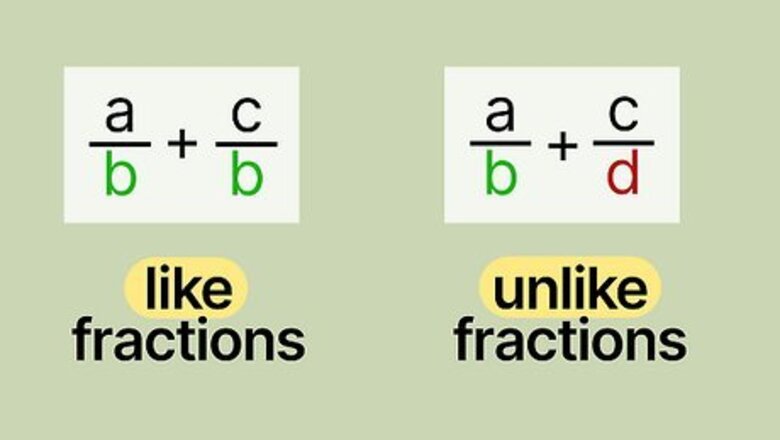
views
Adding Fractions with Like Denominators
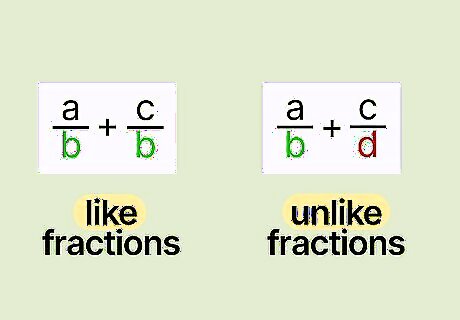
Check the denominators (bottom numbers) of each fraction. If the denominators are the same, you’re dealing with like fractions. For example, the fractions 1/4 and 7/4 both have a denominator of 4. Therefore, they’re like fractions. If the denominators are different, you’re dealing with unlike fractions. And if there’s a whole number with your fraction, then that’s a mixed number. For this method, we’ll work with the following 2 examples: Ex. 1: 1/4 + 2/4 Ex. 2: 3/8 + 2/8 + 4/8
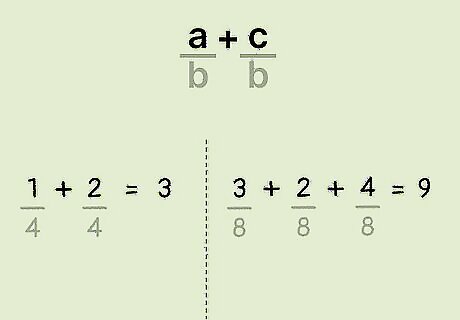
Add the numerators. The numerator is the number on top of the fraction. Add the numerators together just like you would if you were to add regular whole numbers. Look at the following 2 examples. Ex. 1: In the equation 1/4 + 2/4, the numbers 1 and 2 are the numerators. Add the numerators together to get a sum of 3 (1 + 2 = 3). Ex. 2: For the equation 3/8 + 2/8 + 4/8, the numerators are 3, 2 and 4. Add the 3 numerators together to get a sum of 9 (3 + 2 + 4 = 9).
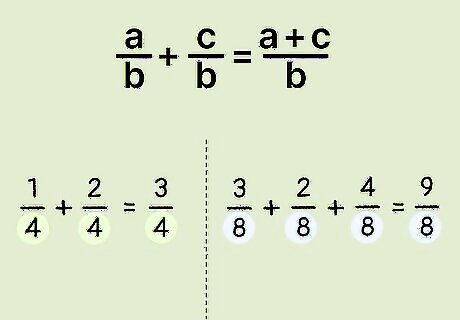
Put the new numerator on top and leave the denominator as is. Take the sum of the numerators and place it on the top of the fraction. When you add like fractions, you don’t add the denominators together. So when adding something like 1/3 + 5/3, the denominator in the final answer will still be 3, not 6. Ex. 1: For the equation 1/4 + 2/4, the new numerator is 3 (1 + 2 = 3), and the denominator will still be 4. This gives us an answer of 3/4 (1/4 + 2/4 = 3/4). Ex. 2: In the equation 3/8 + 2/8 + 4/8, the new numerator is 9 (3 + 2 + 4 = 9), and the denominator is still 8. This yields the answer 9/8 (3/8 + 2/8 + 4/8 = 9/8). Use the equation a / b + c / b = ( a + c ) / b {\displaystyle a/b+c/b=(a+c)/b} {\displaystyle a/b+c/b=(a+c)/b} to make things easier when adding like fractions.
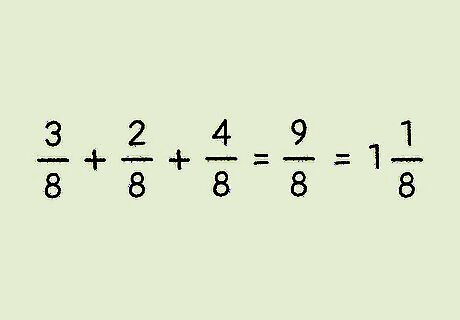
Simplify the new fraction if necessary. Either reduce the fraction by finding a common factor between the numerator and denominator, then divide both the numerator and denominator by the GCF. Or convert an improper fraction to a mixed number by diving the numerator by the denominator, placing the resulting whole number next to the fraction, and making the remainder the new numerator. The two processes look like the following: For example, the GCF of the numerator and denominator in the fraction 5/20 is 5. After dividing both 5 and 20 by 5, you’re left with the reduced fraction 1/4. To turn the improper fraction 9/8 into a mixed number, divide the top number by the bottom number. When you divide 9 by 8, you get 1 as a whole number and a remainder of 1. Place the whole number in front of the fraction and the remainder in the numerator of the new fraction. Leave the denominator the same. The simplified version of 9/8 will thus be 1 1/8. EXPERT TIP Joseph Meyer Joseph Meyer Math Teacher Joseph Meyer is a High School Math Teacher based in Pittsburgh, Pennsylvania. He is an educator at City Charter High School, where he has been teaching for over 7 years. Joseph is also the founder of Sandbox Math, an online learning community dedicated to helping students succeed in Algebra. His site is set apart by its focus on fostering genuine comprehension through step-by-step understanding (instead of just getting the correct final answer), enabling learners to identify and overcome misunderstandings and confidently take on any test they face. He received his MA in Physics from Case Western Reserve University and his BA in Physics from Baldwin Wallace University. Joseph Meyer Joseph Meyer Math Teacher Simplifying a fraction just changes the way the fraction is written. To simplify a fraction, you can cancel out the greatest common factor from the numerator and denominator or convert an improper fraction to a mixed number. This doesn't change the inherent value of the fraction.
Adding Fractions with Unlike Denominators
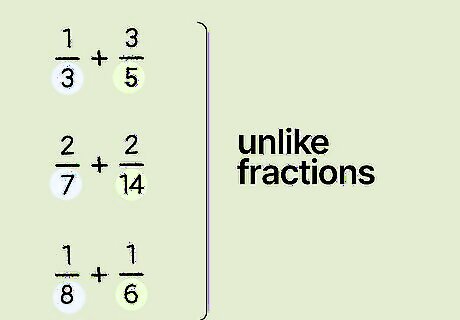
Check the denominators (bottom numbers) of each fraction. If the denominators are different numbers, then you're dealing with unlike fractions. When adding unlike fractions, the most important thing is to make the denominators the same before adding the numerators together. Here are 3 example problems we'll work on in this section: Ex. 1: 1/3 + 3/5 Ex. 2: 2/7 + 2/14 Ex. 5: 1/8 + 1/6
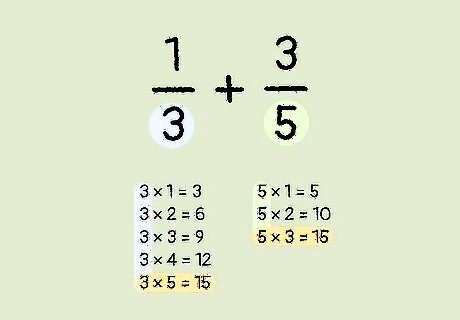
Find the lowest common denominator. The lowest common denominator is the smallest number that’s a multiple of all of the denominators in the equation. To find the lowest common denominator, list out the multiples of the two denominators and find the smallest number that is the same between the two. Ex. 1: Between the denominators 3 and 5, the lowest common denominator is 15. Ex. 2: Between the denominators 7 and 14, the lowest common denominator is 14. Ex. 3: Between the denominators 8 and 6, the lowest common denominator is 24.
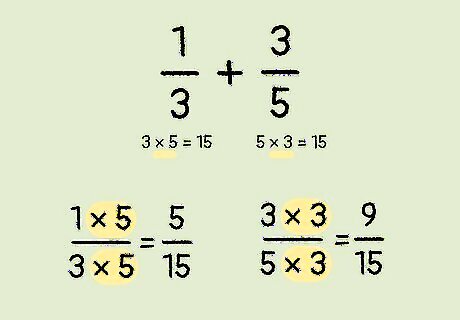
Multiply the numerator by the same multiple needed to get the common denominator. To make sure that the fraction’s value remains unchanged, multiply the numerator by whatever number you needed to multiply the denominator by to change it into the lowest common denominator. For example, if you multiplied the denominator by 2, multiply the numerator by 2 as well. Ex. 1: The lowest common denominator in the equation 1/3 + 3/5 is 15. Multiply both the numerator and denominator of 1/3 by 5 to get 5/15. Then, multiply the numerator and denominator of 3/5 by 3 to get 9/15. Ex. 2: The lowest common denominator in the equation 2/7 + 2/14 is 14. Multiply both the numerator and denominator of 2/7 by 2 to get 4/14. Leave 2/14 as is since it already has 14 as its denominator. Ex. 3: The lowest common denominator in the equation 1/8 + 1/6 is 24. Multiply both the numerator and denominator of 1/8 by 3 to get 3/24. Then, multiply the numerator and denominator of 1/6 by 4 to get 4/24.
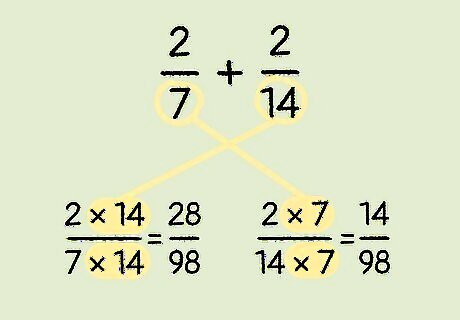
Alternatively, multiply the numerator and denominator of one fraction by the denominator of the other. This ensures that you end up with a common denominator, even if it’s not the lowest common denominator. If you use this method, you’ll likely just have to simplify your fraction at the very end. Ex. 1: For the equation 1/3 + 3/5, multiply the numerator and denominator of 1/3 (1 and 3) by 5 (the denominator of 3/5) to get 5/15. Then, multiply the numerator and denominator of 3/5 by 3 (the denominator of 1/3) to get 9/15. Both fractions now have a common denominator of 15. Ex. 2: For the equation 2/7 + 2/14, multiply the numerator and denominator of 2/7 (2 and 7) by 14 (the denominator of 2/14) to get 28/98. Then, multiply the numerator and denominator of 2/14 by 7 (the denominator of 2/7) to get 14/98. Both fractions now have a common denominator of 98. Ex. 3: For the equation 1/8 + 1/6, multiply the numerator and denominator of 1/8 (1 and 8) by 6 (the denominator of 1/6) to get 6/48. Then, multiply the numerator and denominator of 1/6 by 8 (the denominator of 1/8) to get 8/48. Both fractions now have a common denominator of 48.
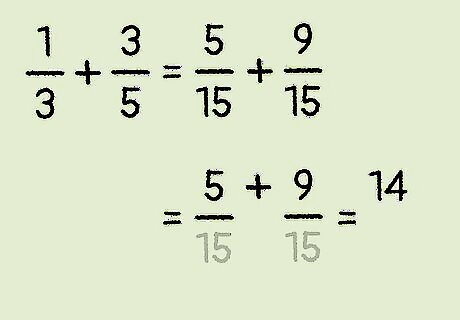
Add the numerators of the two fractions together. Now that the denominators are the same, add the numerators together just like you would add regular whole numbers. For these examples, we’ll use the fractions that share the lowest common denominator. Ex. 1: The new equation with the lowest common denominator is 5/15 + 9/15. Add the numerators together to get 14 (5 + 9 = 14). Ex. 2: The new equation with the lowest common denominator is 4/14 + 2/14. Add the numerators together to get 6 (4 + 2 = 6). Ex. 2: The new equation with the lowest common denominator is 3/24 + 4/24. Add the numerators together to get 7 (3 + 4 = 7).
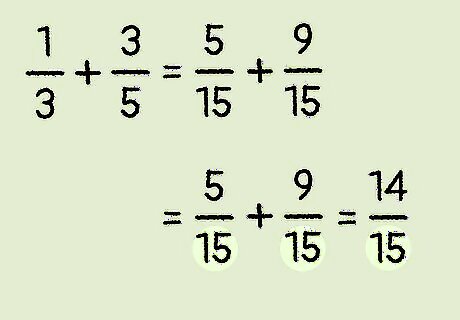
Put the new numerator on top and the common denominator on the bottom. After finding the common denominator, you don’t add the denominators together. So when adding something like 4/14 + 2/14, the denominator in the final answer will still be 14, not 28. Place your new numerator on top of this denominator to get your final answer. Ex. 1: For the equation 1/3 + 3/5, the common denominator is 15 and the new numerator is 14 (5 + 9 = 14). This gives us an answer of 14/15. Ex. 2: For the equation 2/7 + 2/14, the common denominator is 14 and the new numerator is 6 (4 + 2 = 6). This gives us an answer of 6/14. Ex. 2: For the equation 1/8 + 1/6, the common denominator is 24 and the new numerator is 7 (4 + 3 = 7). This gives us an answer of 7/24.
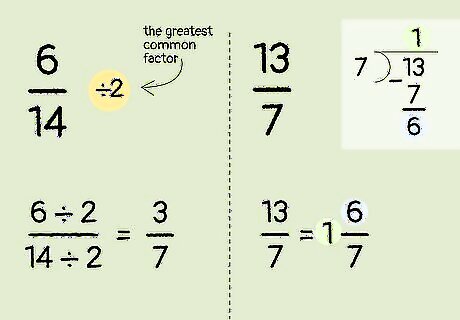
Simplify and reduce. Reduce the fraction by finding the greatest common factor (GCF) between the numerator and denominator. Or, convert the fraction to a mixed number if the numerator is greater than the denominator. Ex. 2: The GCF between the numerator and denominator in 6/14 is 2. Divide the numerator and denominator by 2 to get the reduced answer of 3/7 (6 / 2 = 3 and 14 / 2 = 7). If you got a final answer like 13/7, divide 13 by 7. This gives you a whole number of 1 and a remainder of 6. Place the whole number next to the fraction and the remainder over the denominator to get an answer of 1 6/7.
Adding Mixed Numbers
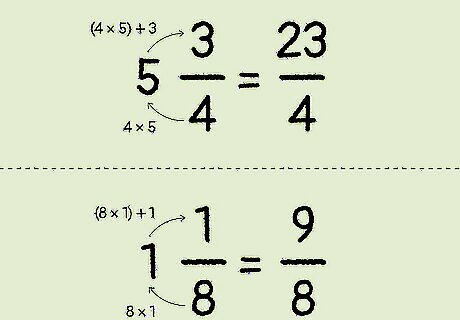
Convert the mixed numbers to improper fractions. Mixed numbers are numbers that have both a whole number and a fraction, such as 3 1/2, 6 2/3, and 1 2/9. To convert the mixed number into a single improper fraction, multiply the denominator by the whole number, then add the product to the numerator. Do this for each of the mixed numbers in the equation. For example, let’s say we have the equation 5 3/4 + 1 1/8. To convert 5 3/4 to an improper fraction, multiply 5 x 4 to get 20. Then, add 20 to the numerator (3) to get a new numerator of 23 (20 + 3 = 23). Your new fraction is 23/4. To convert 1 1/8 to an improper fraction, multiply 1 x 8 to get 8. Then, add 8 to the numerator (1) to get a new numerator of 9 (8 + 1 = 9). The new improper fraction is 9/8.
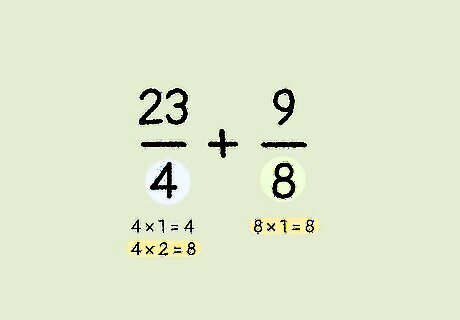
Find the lowest common denominator of the fractions. In the case that your new improper fractions have different denominators, find the smallest multiple that is the same between both denominators. If the denominators are already the same, you don’t have to do anything. For the equation 5 3/4 + 1 1/8, we changed the mixed numbers into the improper fractions 23/4 and 9/8 to give us the new equation 23/4 + 9/8. The two fractions have a lowest common denominator of 8.
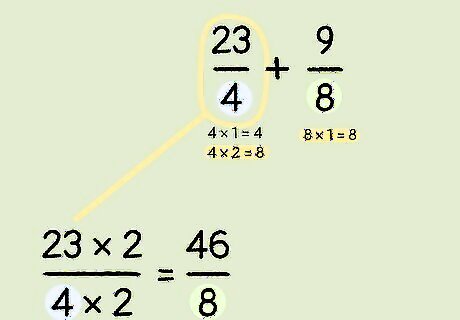
Multiply the numerators by the same numbers needed to get the common denominator. Multiply the numerator by whatever multiple you needed to change the denominator to the lowest common denominator. This ensures that the overall value of the fractions doesn’t change. For example: For the equation 23/4 + 9/8, the common denominator is 8. In that case, multiply both the numerator and denominator of 23/4 by 2 to get a fraction that has the denominator 8. The resulting fraction will be 46/8 ((23 x 2)/(4 x 2)). 9/8 will remain unchanged since it already has a denominator of 8.
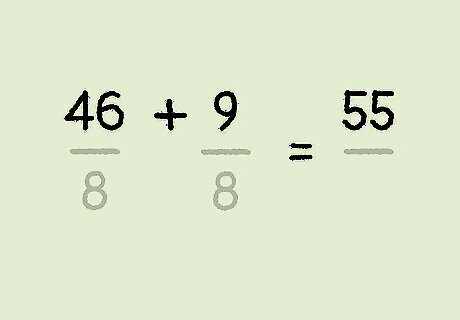
Add the numerators together. Once you’ve made the denominators the same, add the numerators like you would add regular whole numbers. For example: In the new equation 46/8 + 9/8, add the numerators 46 and 9 together to get 55.
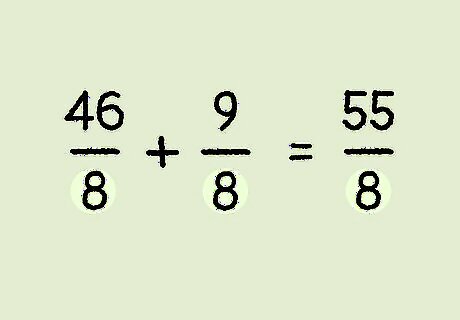
Place the new numerator over the common denominator. To get the final answer, take the sum of the numerators and place it over the common denominator. When adding fractions, don’t add the denominators together. For the equations 46/8 + 9/8, the denominator will remain as 8 instead of turning into 16. The final answer for 46/8 + 9/8 is 55/8.
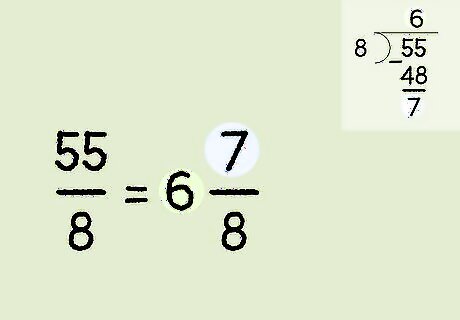
Convert the fraction back to a mixed number. To turn the improper fraction back into a mixed number, count how many times the denominator can fit into the numerator. This will give you the whole number. Then, find the remainder by subtracting the product of the whole number and the denominator from the numerator. Finally, place the whole number next to the fraction and place the remainder in the numerator position. For the improper fraction 55/8, 8 goes into 55 a total of 6 times. The whole number for the mixed number is 6. To find the remainder, subtract 48 (6 x 8) from 55. This yields a remainder of 7. The final simplified answer is 6 7/8.










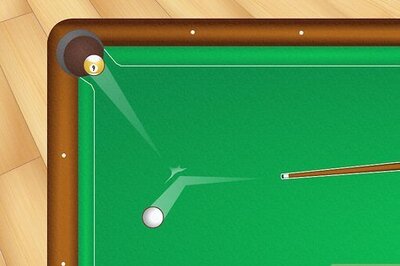




Comments
0 comment